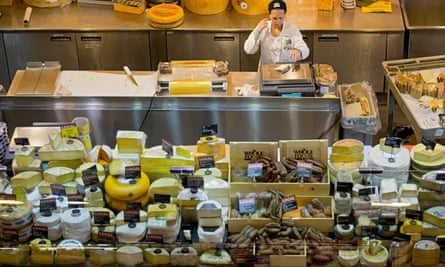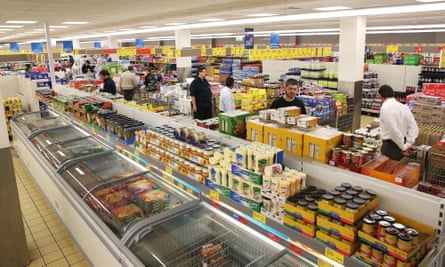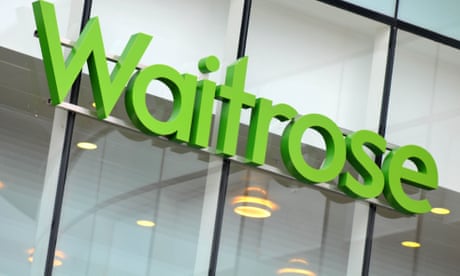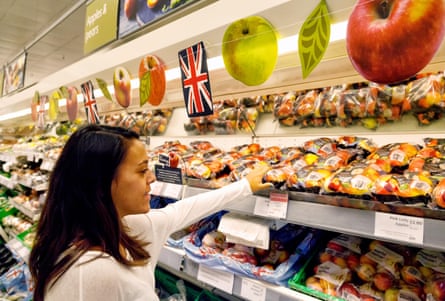New top-tier Australian supermarkets take inspiration from overseas but we are still behind in terms of experience

The cheese counter at Whole Foods in New York. Such fancy supermarkets are a rarity in Australia. Photograph: Ira Berger/Alamy Stock Photo Sofia Levin
Tue 15 Sep 2020
The Guardian
As soon as you enter the Whole Foods Market flagship store in Austin, Texas, staff smile from behind a concierge desk. That’s before you refill your growler with local craft beer from the bar, your bottle with kombucha on tap or visit the on-site taqueria (one of seven food and drink experiences in the store).
As for the aisles, they’re stocked with more canned cold brew nitro coffee, seasonal produce and organic vegan white cheddar chickpea puffs than you can poke an artisan bread stick at. With warm lighting, polished concrete floors and high ceilings, it is the Pinterest board-standard of supermarkets.
Here in Australia, we gush over the value-driven lower end of the supermarket spectrum, stocking up on Costco bulk buys and sheepishly walking out of Aldi with a wine fridge when we were supposed to pick up some milk.
But when fetching groceries might be the highlight of a week in lockdown, those who’ve shopped overseas might wonder: why don’t we have fancy supermarkets?

International brands at the value-driven end of the market like Aldi and Costco have proven popular with Australian shoppers. Photograph: Bloomberg/Getty Images
“A lot of that is due to being a smaller market, but we are definitely behind in terms of experience, as well as the online grocery space,” says the Swinburne University of Technology consumer expert Dr Jason Pallant. “International examples like Whole Foods, Eataly and even now Amazon lead the way. However, as competition becomes more global, we are picking up and overall the experience has been improving.”
Hints of this can be seen in the top tier of Coles’s new three-format structure. One of Australia’s “big two” supermarkets, Coles has started remodelling stores according to suburb affluence and density. Format A carries a whiff of UK’s Waitrose and other upmarket international chains, with customers in Sydney’s Rose Bay and the Melbourne suburb of Hawthorn shopping for fresh pasta, mochi ice cream and pick-and-mix dog treats.
Format B is more standard and the lowest tier, Format C, focuses on efficiencies, such as replacing deli counters with pre-packaged goods. Woolworths has taken a similar approach in a bid to reduce staff costs and waste.

A mochi and macaron stand at Coles’s Format A store in Sydney’s Rose Bay, which opened in May. Photograph: Hanna Lassen/Getty Images for Coles
One major change in Australian supermarkets is the range of ready-made foods available. “The major supermarket chains correctly picked that the next big thing in food was to be healthy and convenient meal replacement services, and that their existing meal offerings perhaps needed an edge to compete,” says Australian National University’s Prof Jane Dixon. “That explains, I believe, why the major supermarket chains have been expanding their ranges of pre-prepared foods and heat-and-serve meal sections.”
Dixon is quick to add that changing the format of supermarkets is nothing new. “Over the decades, the major supermarket chains have been moving back and forth between being huge-format grocery-fresh-food stores, to adding dedicated aisles with ethnically specific food ranges depending on demography, to establishing specialist offshoots in inner metro areas,” says Dixon.
She refers to Woolworths’ acquisition of Macro Wholefoods in the mid-2000s and the launch of Thomas Dux as a “decade-long experiment”. The last Thomas Dux store closed in 2017 and was rebranded as convenience-focused Woolworths Metro.
Aldi and Costco may have disrupted the bottom end of the Australian grocery market, but international brands don’t appear to be interested in penetrating the top end. Amazon, which owns Whole Foods, has been selling grocery items online in Australia for nearly two years.
“It’s unclear why [Whole Foods] hasn’t launched despite opening a huge logistics base in New South Wales,” says Dixon. “Waitrose is having enough trouble surviving in the UK – that is a fiercely competitive market with Sainsbury and Tesco.”

‘They sell duck eggs!’ Waitrose shoppers react to closures
Pallant also points to research suggesting Australian shoppers simply don’t demand the bells and whistles. “We want access to good products at fair prices in a relatively convenient way. It is really only after those core needs are satisfied that we start thinking about higher needs and more experiential elements.”
Another change may be on the horizon. A rocky 2020 has increased consumer desire to shop locally and, during some stages of lockdown restrictions, has forced us to do so. Independent supermarkets are better positioned to support local suppliers and farmers due to smaller inventories and less red tape when it comes to introducing new products.
“Starting with the bushfires, we saw a deliberate effort from consumers to try to support local businesses and producers, and that started flowing on to retailers,” says Pallant. “There is a potential silver lining for the future if this local focus from both consumers and retailers continues.”
Independent supermarkets heavily promote local producers and suppliers. Thai Kee IGA in Sydney’s Haymarket and Boccaccio Cellars in Melbourne’s eastern suburb of Balwyn even started stocking restaurant meals when venues went into lockdown.
“Larger-scale supermarkets have requirements and things they have to stick to and so things are slower to get approved,” says the Thai Kee IGA marketing manager, Wendy Lin. Lin describes Thai Kee, based in Chinatown, as “mainly an Asian supermarket” that has always catered for the local population.
But Coles is catching up. According to a Coles spokesperson, over the last year the company doubled the number of supermarkets with a tailored range. “Our tailored store formats enable us to partner with smaller butchers, bakers and cafes at a local level,” its statement explains.

UK’s
Waitrose offers an upmarket format and has a focus on local producers.
Photograph:
Kumar Sriskandan/Alamy Stock Photo
This approach is similar to that of Waitrose, which has a “small producers’ charter” and claims it aims “to source produce from the areas near to the branches.”
Lin isn’t worried: “Our strategy is to support the community, which I think is what Coles is shifting their strategy towards as well … It’s smart and it’s positive. If anything, I think it’s healthy competition.”
When family-run Boccaccio Cellars transitioned from supplying new Italian migrants into an IGA supermarket some 50 years ago, it referenced high-end European delis and department stores. The Boccaccio CEO, Anthony D’Anna, isn’t surprised that international supermarkets haven’t opened in Australia.
“A lot of those guys consider us the arse end of the world. I can’t see why you’d want to open here when there are so many other markets with the population … There are not enough people here to make it a success.”
For his part, D’Anna has turned down offers of expansion. He says that starting from scratch today and maintaining the same standard would not be financially feasible.
“What we’ve done has been built up over 50 years. If I tried to replicate that, there’s no way I could make it viable. It’s so hard to do these days and that’s why the champions of the industry have been here long term … Those opportunities probably won’t come again.”
Subscribe to our free mailing list and always be the first to receive the latest news and updates.
